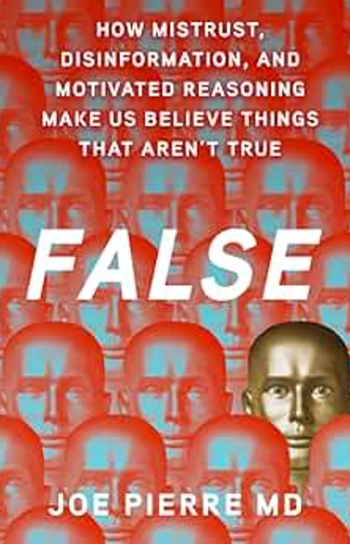
The Uphill Path to Mental Health: A Book Review
In this review of Thomas Insel's book, one doctor analyzes the uphill path from mental illness to mental health.
BOOK REVIEW
by Thomas Insel, MD; Penguin Press, 2022
336 pages • $28.00 (hardcover)
Reviewed by E. Fuller Torrey, MD
Thomas Insel, MD, gets several important things right in his book, Healing: Our Path from Mental Illness to Mental Health. He is right that the public mental illness treatment system in the US is a mess and inferior to most western European countries. He is right that we know what to do, but do not use what we know very well. But he is wrong about one important issue—the role of the National Institute of Mental Health (NIMH). Dr Insel means well and would like to be part of the solution. Unfortunately, because of his blind spot, he continues instead to be part of the problem.
Dr Insel was the director of NIMH from 2002 to 2015. During that time, he oversaw budgets totaling $20 billion and approved a massive transfer of funds from clinical research, which may help people currently affected, to basic research, which may help people in some far off future. In 2017, Dr Insel understood that this transfer of funds had been a mistake1:
“I spent 13 years at NIMH really pushing on the neuroscience
and genetics of mental disorders, and when I look back on that I realize that while I think I succeeded at getting lots of really cool papers published by cool scientists at fairly large costs—I think $20 billion—I don’t think we moved the needle in reducing suicide, reducing hospitalizations, improving recovery for the tens of millions of people who have mental illness. I hold myself accountable for that.”
Five years later, that lesson appears to have been lost and Dr Insel no longer understands the relationship between America’s failed mental illness treatment system and NIMH’s failure to fund clinical research. For example, he writes, on page 45: “Adherence to psychiatric medication is reported to be among the worst for all medications, probably below 50 percent.” As clinicians are aware, drug adverse effects and lack of efficacy are major reasons for this lack of compliance. That is why NIMH, until 2 decades ago, had a very active drug treatment trials program. However, this program was decimated under Dr Insel’s leadership.
In 2006, the first year for which accurate data is available, NIMH funded 16 treatment trials for schizophrenia, bipolar disorder, and major depression. By 2015, this program had been reduced to funding only 3 drug trials, an 81% reduction.2 Dr Insel also praises the use of psychotherapy and other nondrug treatments for selected psychiatric patients; NIMH support for research on such therapies was sharply reduced as funds were shifted from clinical to basic research.
Indeed, one can think of myriad ways America’s mental illness treatment system could have been improved with the wiser expenditure of Dr Insel’s $20 billion. Dr Insel correctly identifies mentally ill persons who are homeless or incarcerated as major problems. The homeless problem could have been improved by a multicenter comparison of the 9 available long-acting antipsychotics, critical for treating homeless mentally ill persons. Each drug was approved by the US Food and Drug Administration simply by proving that it was better than a placebo. As a group the drugs have never been compared, even though clinicians suspect that some are much better than others. Research on their comparative efficacy should have been the task of NIMH. The problem of incarceration of mentally ill persons could also have been improved by NIMH research on programs being used by various states to decrease the rate of reoffending by mentally ill persons being released from jails and prisons. Some states use Psychiatric Security Review Boards, others use Forensic Assertive Community Treatment (FACT) teams, and still others use various forms of conditional release.3 Research on all of them is minimal and they have never been compared.
Still another example is the clubhouse model for psychiatric rehabilitation, also praised by Dr Insel. Although the model has been known for more than 60 years, there still are only a handful of fully functioning clubhouses in the United States. The main reason for this is that NIMH has never undertaken a careful, long-term study of outcomes for clubhouse members. It would show that such outcomes are actually less expensive, as well as being more humane, then allowing mentally ill individuals to undergo an endless odyssey from hospitals to streets to shelters to jails to hospitals and back again. States, counties and cities will spend their mental health dollars on what is cost-effective and what works; such research is the responsibility of NIMH.
From the earliest congressional hearings in 1945, leading to the creation of NIMH, it was clearly stated that its primary purpose was to coordinate “research relating to neuropsychiatric disorders to provide for more effective methods of prevention, diagnosis, and treatment of such disorders.”4 Although basic brain research was envisioned as being part of its research portfolio, NIMH was never intended to be primarily a basic research institute; that was to be the purpose of the National Science Foundation, created by Congress 5 years later. Nor was NIMH intended to organize or deliver mental health services; that was the responsibility of state and local government and, later, the federal Substance Abuse and Mental Health Services Administration (SAMHSA). NIMH’s job was to do research, including research on treatment and services.
Dr Insel, in contrast to 5 years ago, now writes: “To be clear, I have no regrets about NIMH funding for genomics and neuroscience,” [page xxvi] even as he acknowledges that the genomics research has produced nothing of value “that is ready for clinical use in diagnosis or treatment” [page133]. In an interview accompanying a review of the book he further noted that,5
The mental illness crisis is “not a research problem; it’s an implementation problem.” Good treatments for serious diseases like schizophrenia and bipolar disorder already exist…(I)t is not the job of scientists at the NIMH to provide services.
NIMH scientists should of course not be responsible for providing psychiatric services, but they should be responsible for improving the treatments that already exist, as well as carrying out research on how treatment in the broadest sense of the word can be improved. Until NIMH understands this, our path from mental illness to mental health will be largely uphill.
The opinions expressed are those of the author and do not necessarily reflect the opinions of Psychiatric Times™.
Dr Torrey is the founder of the Treatment Advocacy Center and the author of American Psychosis: How the Federal Government Destroyed the Mental Illness Treatment System.
References
1. Rogers A. Star neuroscientist Tom Insel leaves the Google-spawned Verily for . . . a startup? Wired. May 11, 2017. Accessed August 5, 2022.
2. Torrey EF, Simmons WW, Hancq ES, Snook J.
3. Torrey EF, Dailey L, Lamb HR, et al. Treat or repeat: a state survey of serious mental illness, major crimes and community treatment. Treatment Advocacy Center. September 2017. Accessed August 5, 2022.
4. Congressional hearings, subcommittee of the committee on interstate and foreign commerce, House of Representatives. H.R. 2550. A Bill to Provide for, Foster and Aid in Coordinating Research Relating to Neuropsychiatric Disorders; to Provide for more Effective Methods of Prevention, Diagnosis, and Treatment of Such Disorders; to Establish the National Neuropsychiatric Institute; and for Other Purposes. Sept 18, 19, and 21. 1945. Government Printing Office; 1945.
5. Barry E. The ‘nation’s psychiatrist’ takes stock, with frustration. The New York Times. February 22, 2022. August 5, 2022.
Newsletter
Receive trusted psychiatric news, expert analysis, and clinical insights — subscribe today to support your practice and your patients.

















